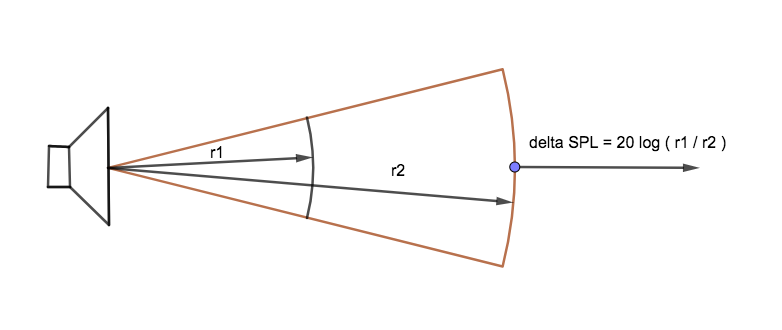
Midrange Room Influence
The room influences midrange frequencies with a mix of modal and interference based effects.
Allow me to declare the midrange frequency (MF) range to reach from 100 Hz to about 2 kHz. This is the range of low male voices up to the presence range of female voices. It places „Kammerton A“ = 440 Hz in it’s geometric middle (squareroot of (2000 * 100) = 447 Hz).
I wrote about modal effects in the low frequency (LF) blog, and interference in the high frequency (HF) blog.
Please look back to the interference blog for the basics of comb filtering effects.
Additional problems
If you remember the LF blog, it is hard enough to find listening and loudspeaker positions that balance the room mode effects well.
One more problem are strong first reflexions from room boundaries close to listener and loudspeakers. These have strong influence on the upper bass / lower midrange in most hifi and studio setups.
Imagine a pair of speakers set up with their woofer / midrange diaphragms about 1 m from the front wall. The front wall reflexion arrives about 6 ms behind the direct sound (travelling 2 m longer than direct sound). Their interference with direct sound creates strong nulls around 86 and 257 Hz, and a peak around 172 Hz.
The magnitude of this effect is often as large as -15 / +4 dB, and produces strong low-midrange coloration.
The more you pull the speakers away from the front wall, the deeper those comb filter effects will cut in.
But sidewalls and floor will influence with comparable amplitude. Therefore, we can try to balance these first strong reflexion comb filters by varying the 3 distances until the overall effect gets smoother.
How about absorbing those reflexions?
Porous absorbers need to be one quarter wavelength thick to absorb the corresponding frequency.
Due to the long wavelengths involved (see the wavelength blog), this is hard to achieve!
But not impossible, if you allow for special large acoustical treatments. Reactive elements (resonators) may not work as expected, because they take time to build up their full absorbtive potential. Nice for room modes, but less effective with first order reflexions. (First order reflexions are those that hit the boundaries only once before arrival.)
In small recording studio control rooms very often a pair of smaller monitor speakers is placed even closer to the front wall. Sometimes with a shallow layer of absorption inbetween, that absorbs nothing below 200 Hz. The effect is missing overtones of LF notes, no attack on bass drums etc. A strong null somewhere around 100 Hz.
Similar things may happen to small stand mounted speakers in living rooms. Add here the influence of the floor reflexion. It may very well be delayed similar to the front wall reflexion. The coloration will be tremendous.
An additional nasty characteristic of front wall and floor reflexions is that they arrive from nearly the same direction as the direct sound. Very hard to discriminate for our ears!
So what to do?
As mentioned above, balance the delay times of those strong first reflexions by varying the distances. Hopefully, this is in harmony with LF room mode coupling.
A fast way to perform the task without measuring instruments is to listen to your own voice while walking to possible loudspeaker positions. You will hear where colorations are high or low. Please mind that for better results you should maintain the vertical height of you woofers …
Even better, ask a friend to perform the talking and walking task while you listen at the potential listening position. And remember, a room boundary (eg. the back wall) close to your listening position will produce similar effects!
The distance law
Another way to minimize room influence is nearfield listening. It makes use of the distance law, that calculates the SPL difference between sound paths.
Imagine to sit 1 m in front of your speakers, these set up 1 m from the front wall. The front wall reflexion runs 3 m until arrival. According to the equation in the heading picture the reflexion will be 20 * log (1m / 3m ) = -9.5 dB down relative to direct sound. Play with that formula to see the difference in relative levels while you move away from the speakers! It will show you the advantage of nearfield listening.
Even if you manage to move the speakers away from the walls, the floor reflexion will remain. Too soon, too strong! Nevertheless, much higher „fidelity“ than having similar pathlengths of front wall AND floor reflexions.
Some speakers take advantage of boundary reflexions to enhance their low end. If done well (remember the „Allison effect“?) this works nice. But a speaker at the front wall needs to be very shallow to avoid midrange coloration from that reflexion!
Which way to heaven?
An ideal situation may be combined good balance of reflexions and some absorption. My personal law for this is the 10 ms / 10 dB rule. Delay reflexions at least 10 ms to direct sound and attenuate them more than 10 dB.
If you happen to listen in a nicely proportioned room that is large enough, this should be possible.
Or using full range horn loudspeakers that are large enough to somewhat control even their low end.
Place them according to LF needs and enjoy, even without additional MF/HF absorption.
Anyway, fixing the problem with the floor reflexion is the job of the loudspeaker designer.